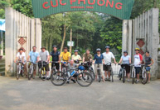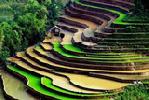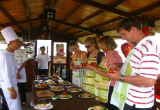Total area: 331,688 km² Population: 86 Mils people Location: 16° 0' N and 106° 0' E
Geography
Three quarters of Vietnam's territory consists of mountains and hills. Vietnam is divided into fourdistinct mountainous zones.
The Red River Delta, or Northern Delta: This region stretches for 15,000 sq.km. Over time, deposits of alluvium carried from the Red River and Thai Binh River have accumulated to form the delta. The ancient Viet people settled at the junction of the two rivers . At that time, the wet rice civilization was established
The Mekong River Delta, or Southern Delta: This region is approximately 40,000 sq. km. The land is very fertile and has favorable climate conditions for agriculture. As a result, it is the largest rice growing region in Vietnam.
|
The coastal line
Vietnam's coastline is 3,260 km long. If you have a chance to travel along the coast of Vietnam, you will be able to enjoy the beautiful beaches of Tra Co, Sam Son, Lang Co, Non Nuoc, Nha Trang, Vung Tau, and Ha Tien. In some places, you will see mountains jutting out to the sea. One such magnificent site is Halong Bay, which has recently been two times listed as a World Heritage Site by the UNESCO.
The forest and national parks
The forests of Vietnam account for most of the total land area. National parks are preserved by the state and follow a steady development plan. Some of the more famous national parks located throughout the country include Ba Vi in Ha Tay, Cat Ba in Haiphong, Cuc Phuong in Ninh Binh, Bach Ma in Hue, Cat Tien in Dong Nai.
Climate
Vietnam is located in both a tropical and a temperate zone. It is characterized by strong monsoon influences, but has a considerable amount of sun, a high rate of rainfall, and high humidity. Regions located near the tropics and in the mountainous regions are endowed with a temperate climate. The annual average temperature ranges from 22ºC to 27ºC. In Hanoi, the average temperature is 23ºC, in Ho Chi Minh City it is 26ºC, and in Hue it is 25ºC.
Language
Vietnamese, the official language, is spoken by the majority of the population (see Austro-Asiatic Languages). The use of French, a remnant of colonial times, is declining. Some Vietnamese people who live in urban areas speak other languages, such as English and Russian. Khmer, Montagnard, and Cham are spoken primarily in the interior.
Currency
The currency of Vietnam is the dong (VND)
|



|
Early history
The Vietnamese as an ethnic group had been formed and developed early in the Red river and Ma river delta situated in northern part of the present-day Vietnam. Generations to generations, people moved from highland and mountainous areas to the plains, developed new lands for cultivation. They constructed a system of irrigation dams and dykes to tame the mighty Red River, the river that brought about several devastating floods every year. It is the process of continuous labor to control water - to fight against flood, storm and drought, to build up irrigation dams and canals for agricultural cultivation that formed the paddy rice civilization and the commune culture.
The feudalism
In the 10th century AD, the Vietnamese had won their freedom and built up an independent state named Dai Viet. The country was under the ruling of many national feudal dynasties, among which the most important ones are the Ly Dynasty (11th and 12th century), the Tran Dynasty (13th and 14th century), the Le Dynasty (15th, 16th and 17th century) with their centralized administration, strong army forces and a highly developed economy and culture. Vietnam's long and tough struggles of resistance against the invasions of the Song (11th century), the Yuan or the Mongols (13th century), the Ming (15th century) had acquired glorious victories. Vietnam became stronger, all its ethnic groups became more united and the country moved into a new prosperous period after each struggle.
In the 17th and 18th century, feudalism in Vietnam was considerably weakened. Peasants ceaselessly rose up in revolts that led to the Tay Son movement (1771-1802). However, with foreign aid, Nguyen Anh soon took over the ruling power and the Nguyen Dynasty was established, which was the last royal dynasty in Vietnam.
Struggle for national liberation
In the middle of 19th century (1858), French colonialists began to invade Vietnam. The incompetent government of the Nguyen gradually gave in and from 1884, French colonists established a protectorate and a colonial government that controlled the whole territory of Vietnam.
Nguyen Ai Quoc, who later became President Ho Chi Minh, traveled abroad to find the way to save the country. He laid the foundations for the Vietnam Communist Party, which was founded on 3rd February 1930. Under the leadership of the Communist Party, the Vietnamese people rose up against French colonization and Japanese occupation, organized the Great National Uprising in August 1945 and established the Democratic Republic of Vietnam on 2nd September 1945.
The south Vietnamese regume ruled by Bao Dai ( the last King of the Nguyen Dynasty) was the result of the agreement between the French and the US government.
The reunification
In the spring of 1975, the patriotic armed forces of Vietnam swept across the country in the great general offensive and overthrew the Saigon government. The southern part of Vietnam was liberated and the country was united as one.
On 25th April 1976, the Democratic Republic of Vietnam was renamed into the Socialist Republic of Vietnam, which governs both northern and southern parts in its territory.
The society
Kinship plays an important role Vietnam. Unlike Western culture's emphasis on individualism, Eastern culture values the roles of family and clanship. Comparing with Eastern cultures, Chinese culture values family over clan while Vietnamese culture values clan over family. Each clan has a patriarch, clan altar, and death commemorations attended by the whole clan.Most inhabitants are related by blood.
Marriage
In the past, both men and women were expected to be married at young ages. Marriages were generally arranged by the parents and extended family, with the children having limited say in the matter.
In modern Vietnam, this has changed completely as people choose their own marriage partners based on love, and in consideration primarily to their own needs and wants.
Religion and Philosophy
Religion in Vietnam has historically been largely defined by the East Asian mix of Buddhism, Confucianism, and Taoism. They are the so-called Tam Giáo, or "triple religion." Today it has become more diverse including other religions such as Catholicism, etc. Vietnamese Buddhism has typically been the most popular. This fits perfectly with the "triple religion" concept, making it difficult for many Vietnamese to identify exactly which religion they practice
Besides the "triple religion," Vietnamese life was also profoundly influenced by the practice of ancestor worship as well as native animism. Most Vietnamese people, regardless of religious denomination, practice ancestor worship and have an ancestor altar at their home or business, a testament to the emphasis Vietnamese culture places on filial duty.
Cuisine
Vietnamese cuisine is extremely diverse, often divided into three main categories, each pertaining to Vietnam's three main regions (north, central and south). It uses very little oil and many vegetables, and is mainly based on rice, soy sauce, and fish sauce. Its characteristic flavors are sweet (sugar), spicy (serrano peppers), sour (lime), nuoc mam (fish sauce), and flavored by a variety of mint and basil.
Clothing
The most popular and widely-recognized Vietnamese national costume is the Áo Dài. Áo Dài was once worn by both genders but today it is worn mainly by females, except for certain important traditional culture-related occasions where some men do wear it. Áo Dài is derived from the Chinese Qipao, although it consists of a long gown with a slit on both sides, worn over cotton or silk trousers. Áo Dài is elegant and comfortable to wear. Áo Dài was likely derived in the 18th century or in the royal court of Hue. White Áo dài is the required uniform for girls in many high schools across Vietnam. Some female office workers (e.g. receptionists, secretaries, tour guides) are also required to wear Áo Dài.
In daily life, the traditional Vietnamese styles are now replaced by Western styles. Traditional clothing is worn instead on special occasions, with the exception of the white Áo Dài commonly seen with high school girls in Vietnam.
Music
Vietnam has got some 50 national music instruments, in which the set of percussion instruments is the most popular, diverse and long-lasting such as trong dong (copper drums), cong chieng (gongs), dan da (lithophone), dan to rung... The set of blowing instruments is represented by flutes and pan-pipes, while the set of string instruments is specified by dan bau and dan day.
The Vietnamese folksongs are rich in forms and melodies of regions across the country, ranging from ngâm thơ (reciting poems), hát ru (lullaby), hò (chanty) to hát quan họ, trong quan, xoan, dum, ví giặm, ca Huế, bài chòi, ly. Apart from this, there are also other forms like hát xẩm, chầu văn, and ca trù.
Theatre
Water Puppetry is a distinct Vietnamese art which had its origins in the 10th century. In Water Puppetry a split-bamboo screen obscures puppets which stand in water, and are manipulated using long poles hidden beneath the water. Epic story lines are played out with many different puppets, often using traditional scenes of Vietnamese life. The puppets are made from quality wood, such as the South East Asian Jackfruit tree. Each puppet is carefully carved, and then painted with numerous successive layers of paint to protect the puppets.
Despite nearly dying out in the 20th century, Water Puppetry has been recognised by the Vietnamese Government as an important part of Vietnam's cultural heritage. Today, puppetry is commonly performed by professional puppeteers, who typically are taught by their elders in rural areas of Vietnam. It is now extremely popular with tourists, and is performed at the National Museum in Ho Chi Minh city and in specialist theatres. In 2007 a Water Puppet troupe toured the USA to acclaim.
Weather
Vietnam's elongated shape stretching from the tropics to the subtropics zone accounts for the varied climate in the country. Vietnam is an year round destination, when one part of Vietnam is cloudy and rainy, there are other parts of the country that can be sunny and warm
North Vietnam enjoys 4 seasons, meanwhile Central and South have 2, rain and dry seasons. Heat and humidity are typical weather of Vietnam.
Weather is often a determinant factor in travel planning. Since Vietnam covers several climatic zones, the weather can change significantly traveling north to south. The chart below provides average daily minimum/maximum temperatures in degrees Celsius and average rainfall in millimeters. Please refer to this chart and our suggested packing list later in this document when deciding what to pack for your trip.
Clothing
Light, comfortable, easy to launder clothing is recommended. Winter months in Hanoi and rainy season in the central region can get cool so a sweater or light jacket will come in handy. Good walking shoes and sandals that can be easily removed are recommended especially when visiting temples and people's homes. Ensure you have suitable clothing packed for visiting temples and pagodas that you can cover up with. E.g. Shirts and long pants. No dresses, shorts, singlets, string tops or revealing clothing should be worn to temples and pagodas.
What to Pack
Vietnam is generally a casual country by western standards although people do like to dress in their Sunday best whenever the opportunity arises therefore simple and casual clothes are appropriate for almost any occasion.
The year round heat and humidity in the south, especially Ho Chi Min City makes lightweight quick dry clothing the most appropriate. The north and central highlands get cool enough for sweaters or light jackets for much of the year but the northern highlands will require cold weather clothes in the winter.
If you are not participating in any trekking tours sandals and lightweight shoes are sufficient. If trekking is included in your itinerary you will need trekking boots.
Visa
Visitors must obtain visa approval prior to entry. A tourist visa for Vietnam can be obtained from any Vietnam Embassy or consulate office world wide. Visas are valid for 30 days and can be extended through our head office in Vietnam.
Immigration procedures
All visitors must complete an Entry/exit Card. This should be submitted together with passport and visa to the Immigration Department officials at the point of entry. The Exit portion will be torn off and returned to the visitor, who should retain this for presentation upon departure. It is a good idea to staple this into your passport on the page that has your visa stamp.
Customs procedures
All visitors must complete a Customs Declaration Form. Both the copy and the original will be stamped. The Customs officers will retain the original copy while the copy (so called yellow paper) will be given back to the visitor, who must submit it upon departure.
hese forms will be passed to you on your flight to Vietnam . Every form asks for your contact address in Vietnam .
Airport Departure Tax
There is a international departure tax of US$ 14 in Saigon and US$ 14 in Hanoi . Domestic departure taxes are included in air fare.
Working hours
Government offices and banks are open Monday to Friday. The banks close at 3:30 p.m. If you need to visit a government office do not do it during lunch periods. These usually last 1 to 2 hours. Post offices are open 7 days a week.
Most shops will be open until around 9 p.m. Snacks and bars will close around midnight however there a few new nightclubs in Hanoi and Saigon that stay open into the wee hours.
Electricity
The national electricity system is 220 volts. Connections are either a round two-pin plug or a flat two-pin plug. Beware if you are using electrical appliances and laptop computers, as there are power surges and frequent power cuts.
Tipping
Tipping for good service is not expected but is always appreciated in these developing nations. It is customary, though not compulsory, to tip tour guides and drivers at the end of a tour. Hotel and station porters should also be tipped.
Photography
Taking photographs of anything to do with the military, airports, police etc. is prohibited. When taking photographs of local people, especially the older folk it is polite to ask their permission first and respect their wishes. We recommend you to develop photos in Vietnam for cheap price but high quality.














